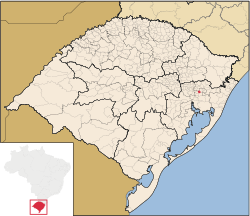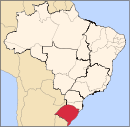
Porto Alegre is the capital and largest city of the Brazilian state of Rio Grande do Sul. Its population of 1.3 million inhabitants (2022) makes it the 11th-most populous city in the country and the center of Brazil's fifth-largest metropolitan area, with 4.4 million inhabitants (2010). The city is the southernmost capital city of a Brazilian state.

Rio Grande do Sul is a state in the southern region of Brazil. It is the fifth-most populous state and the ninth-largest by area. Located in the southernmost part of the country, Rio Grande do Sul is bordered clockwise by Santa Catarina to the north and northeast, the Atlantic Ocean to the east, the Uruguayan departments of Rocha, Treinta y Tres, Cerro Largo, Rivera, and Artigas to the south and southwest, and the Argentine provinces of Corrientes and Misiones to the west and northwest. The capital and largest city is Porto Alegre. The state has the highest life expectancy in Brazil, and the crime rate is relatively low compared to the Brazilian national average. The state has 5.4% of the Brazilian population and it is responsible for 6.6% of the Brazilian GDP.

Nova Petrópolis is a municipality in the Southern Brazilian state of Rio Grande do Sul. The main seat of the municipality is also called Nova Petrópolis. It is located in the Serra Gaúcha region, at 29º22'35" South, 51º06'52" West, about 90 km (56 mi) north of Porto Alegre, the state capital city. Nova Petrópolis is situated at an average altitude of 580 m (1,900 ft) above sea level and covers an area of 293 km2 (113 sq mi).

Novo Hamburgo is a municipality in the southernmost Brazilian state of Rio Grande do Sul, located in the metropolitan area of Porto Alegre, the state capital. As of 2020, its population was 247,032. The city covers an area of 217 km2 (84 sq mi), and the average temperature is 19 °C (66 °F), which is mild for the region. The Sinos River runs through the urban area.
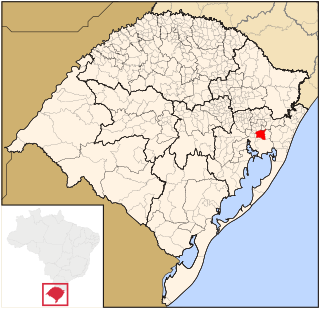
Gravataí is a Brazilian municipality near Porto Alegre at the Rio Grande do Sul State. Its population is approximately 280,000 people, making it the sixth most populous city in the state.

Esporte Clube Novo Hamburgo, commonly referred to as Novo Hamburgo, is a Brazilian football club based in Novo Hamburgo, Rio Grande do Sul. It currently plays in Campeonato Gaúcho Série A, the first level of the Rio Grande do Sul state football league.

Canoas is a municipality in the state of Rio Grande do Sul, Brazil, forming part of the Greater Porto Alegre area. It is the largest municipality of the metropolitan region of Porto Alegre and the third largest municipality of Rio Grande do Sul. Officially declared a city on June 27, 1939, after its separation from São Sebastião do Caí and Gravataí, Canoas derives its name from the historical crafting of canoes in the area. It is the second largest city in the Porto Alegre metropolitan area, with the third-largest population and the third-highest GDP in the state. It is also ranked as the 79th most populous city in Brazil.
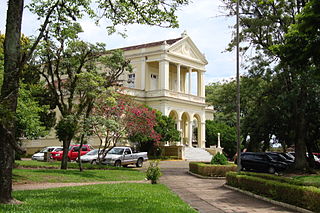
Santa Cruz do Sul is a city in central Rio Grande do Sul, Brazil. The city has an estimate 131,000 inhabitants as of 2020 and sits about 150 km from the capital city of the state, Porto Alegre. The city enjoys a high standard of living and gross income per capita is 2.5 times greater than that of the state of Rio Grande do Sul as a whole.

The Porto Alegre Metro is a transit system operated jointly by the federal government, the state government of Rio Grande do Sul and the city of Porto Alegre through the company Trensurb in Brasil. It has 22 stations, totaling 43.8 kilometers (27.2 mi) of route, and carries about 175,000 users a day.

Estância Velha is a municipality located in the state of Rio Grande do Sul, Brazil. According to 2021 IBGE data, it has a population of 51,292 inhabitants.

Ivoti is a municipality in the Brazilian state of Rio Grande do Sul, located in the Porto Alegre metropolitan area. The population is 24,690 in an area of 63.15 km2.

Tupandi is a municipality in the state of Rio Grande do Sul, Brazil.It has a population of approximately 4,500 inhabitants and covers an area of 47.4 square kilometers. The municipality is situated in the Metropolitan Region of Porto Alegre, and it is located approximately 80 kilometers west of the state capital.
Companhia Zaffari is the tenth largest Brazilian company that has a chain of supermarkets and hypermarkets in Rio Grande do Sul, and São Paulo.

The Tietê Bus Terminal is the largest bus terminal in Latin America, and the second largest in the world, after the Port Authority Bus Terminal in New York City. The terminal is located in the Santana district in the city of São Paulo, Brazil. The official name in Portuguese is Terminal Rodoviário Governador Carvalho Pinto, named after Carlos Alberto Alves de Carvalho Pinto, a former Governor of the State of São Paulo.
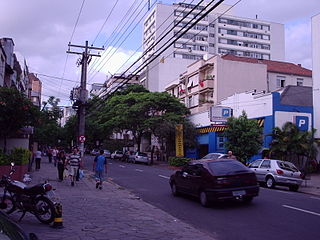
Bom Fim is a neighborhood in the city of Porto Alegre, the state capital of Rio Grande do Sul in Brazil. It was created by the law number 2022 from December 7, 1959.

Farroupilha is a neighbourhood (bairro) in the city of Porto Alegre, the state capital of Rio Grande do Sul, in Brazil. It was created by Law 2022 from December 7, 1959.

Bom Jesus is a neighbourhood (bairro) in the city of Porto Alegre, the state capital of Rio Grande do Sul, in Brazil, with a population of 11202, and covering an area of 2.6 million km². It was created by Law 5799 from December 15, 1986, but had its limits modified by Law 6594 from January 31, 1990.
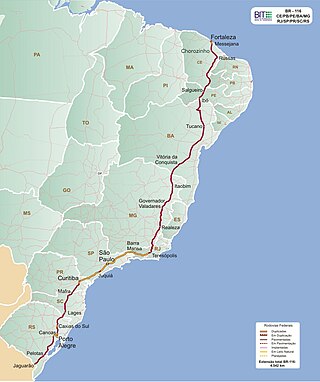
BR-116 is a federal route of highways of Brazil and the longest highway in the country, with 4,542 km (2,822 mi) of extension. The road connects Fortaleza, Ceará, one of the largest Northeast Brazil metropolises, to the southern city of Jaguarão, Rio Grande do Sul, in the border with Uruguay. It is also the longest highway in the country to be completely paved. It is considered one of the most important highways in the country, along with BR-101.
Marciano José Pereira Ribeiro was a Brazilian doctor and politician. He was the president of Rio Grande do Sul in two terms in 1835 and 1836.

The Jacuí Delta is a hydrographic complex of islands (archipelago), canals, swamps and ponds in Rio Grande do Sul, Brazil, formed by the meeting of the Jacuí, Caí, Sinos and Gravataí rivers, whose waters constitute Lake Guaíba.

